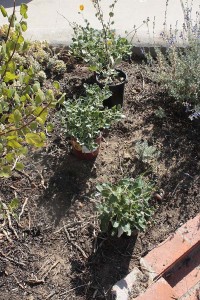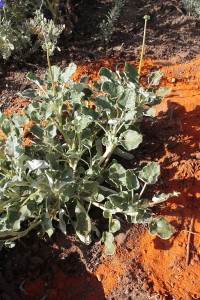It’s been a bad year for pocket gophers. I’ve been cleaning up the garden for our annual big July 4th party, dealing with gopher damage and generally getting everything pretty-like. One large spot in the front–just about the first zone of the garden visitors will encounter–is totally bare and calls out for some new plants to fill in the space. But the last thing I wanted to do is to install something new that would turn into expensive gopher chow.
I decided that I would try to place some new plants in the dead zone, but wanted to see if I couldn’t try something to deter the gophers. Gopher bait pellets are popular, but I can’t say that they’ve worked for me. How can you tell if something is working when the creature you’re after lives 99.9% of the time underground and their damage seems to come in random spurts? And I worry about the cat discovering a poisoned gopher. Gopher-killing traps are popular, and it’s the one method that seems to have the best chance at success. Still I’m not sure I’m ready to go there.
I’ve tried castor bean-based repellant. I’ve tried blood meal. Both things that are supposed to keep the creatures at bay, but I don’t know that they’ve worked for me for longer than a few days. And the idea of spreading blood meal fertilizer around native plants at the start of what’s summer dormancy for many of them didn’t seem like too bright an idea. (Let me force feed you some bratwurst while you’re trying to get to sleep…) One thing I haven’t tried is chili powder.
I admit that this is just an experiment, maybe one that’s doomed to fail. The only things I have going on my side are the facts that, 1) there’s at least one commercial product out there that combines blood meal with chili powder, and 2) you sometimes see references on gopher control using chili, usually in combination with something like garlic. Since I don’t want to do blood meal, the chili powder alone might do something.
And if chili powder might work, why not use the most industrial-strength stuff you can your hands on? It’s not pepper spray, but the local Indian grocer sells 880 grams of extra-hot ground pepper for less than five dollars–less than half the price for the blood-meal/chili mixture I’ve seen. I cook with the stuff, but a half teaspoon will make a large batch of food sizzle and scare away most of my Ohio relatives. It might work for gophers, too.
So, into the planting holes I mixed up a recipe of soil mixed with generous amounts of the chili powder, about 1 quarter cup per hole. Next, into the holes go the three new San Miguel Island buckwheats. They’re not the most exotic of the California native plants, but I was pretty happy to find several well grown examples in a local generalist nursery. If you see a business doing something good, why not support them?
Finally the plants got a healthy top-dressing of the chili powder. What I didn’t use on the new plants I spread around a few other plants that seem to be favorite gopher menu items. This is how it looks before watering it in, pretty glaringly orange-red. It looks closer to normal after you soak it in a bit.
One Big Caution: Although chili powder is a natural product, it’s still a nasty irritant. Wear gloves. A respirator and goggles might be a good addition on a windier day. I’m not saying this for dramatic effect. Wind blew some in my eyes and I suffered the expected effect–no surprise. But I also rubbed my gloves on the side of my face, only to have my face burn like a second degree sunburn for half an hour.
Will all this fail and collapse into a pile of chili powder induced flames? Dunno, but it’ll be an interesting experiment.




Wow – that’s some serious looking stuff! ha ha ha!
lol! Ohio relatives…
Let’s hope your gophers don’t enjoy their new ‘treats’ I once watched as a gopher popped up time after time to grab every leaf of a dandelion…and once saw a 8″ tall Wytheia plant twisting and waving and it slowly disappeared into the ground.
The experiment sounds real good. Good luck!
Oh, I’m liking this idea! Around here we call them ‘pot guts’ and they are crazy-busy destroying my garden this summer. I’d love to foil their plans with a few bags of this stuff. 🙂
About fire and fynbos and chaparral? Invasive alien Port Jackson wattle, eucalyptus and pines blaze too hot for the fynbos seeds. Fynbos does need to burn, but not as often as idiots discarding cigarette ends, or arsonists, ‘think’!
If you have room in your life, consider getting the right good-sized dog. I watched my parent’s german shepherd mix sneak up on a groundhog and take it out with a few quick shakes. Very elemental, but effective.
This is dangerous writing territory, however. My sister-in-law blogged about trapping a groundhog and releasing it elsewhere. She received so many comments about the harm these animals cause in the country (their holes can break cows’ legs) and how she should have killed it that she had to take her post down.
Groundhogs seem to inspire particularly high emotion in the world of varmits. I love Michael Pollin’s account of considering driving one out with gasoline and a match.
Wendy, so far so good, but it’s only been a week…
Sue, like you I’ve seen a few plants move around, animated by unseen forces below. If you don’t know what’s happening it can be a tad unsettling…
Kate, “pot guts” huh? Love the name, but I’m sorry you’re having to contend with their damage. You must be doing something right, though, if you’re growing irresistibly tasty plants.
EE, so you have the same issues with unthinking members of the human species down where you are? I wish the realization that humans are alike wherever you go came out of a more positive thing the species has done…
Cindy, my cat has come inside the house with a couple, though at the time I didn’t know they were gophers and let them go. In her middle age she’s more interested in sleeping in the garden than looking for interesting rodents. I can see how this could be a touchy subject. There was a long thread about pocket gophers on my local native plant listserv where you saw the whole spectrum of reactions aired. Interestingly, even though it was a group of folks dedicated to native plant species, there wasn’t much sympathy for this native rodent.
Oh please…follow up with a progress report. Many of us are desperate!
i like how there’s a graphic of a deer, or some other antlered creature, on the packaging of your gourmet chili deterrent. perhaps that’s a good indication of other four-legged creatures it can work on… let us know how it works.
I’ve found that some natives are naturally not attractive to gophers, buckwheats among them. Other natives I’ve found that gophers like to avoid are Matilija poppies and sages.
This makes sense since gophers are native to California and the evolutionary pressure would have been towards mitigating gopher predation.
On the other hand, the Channel island origin Lavatera assurgentiflora, may not have suffered predation in its island home since it seem to be a favorite gopher snack.
James, how are the buckwheats? I happen to plant a red buckwheat right over a big gopher hole or burrow and have been watching it like a hawk ever since reading your post. I haven’t used any prevention,…using Brett’s method, planting things they don’t find tasty….and wondering if that works..time will tell, but am wondering about yours.
Ricki and Sue, so far so good. No gopher activity that I can see so far. But I’ll give it more time to consider it a success since I haven’t seen gopher activity anywhere in the garden since I sprinkled the chilli powder around. I’ll do a formal followup soon.
Andrea, interesting…I wonder how deer would react to the chile!
Brent, in my garden the gophers do seem to leave some of the natives alone. I don’t have Matilija poppies, but the sages do seem to be avoided. The two buckwheats species I had in the front garden don’t seem immune, though. My Saint Catherine’s lace started out growing really well, but the last two years it’s looked awful and I think gophers are involved. The nearby plants of E. arborescens now are the site of the biggest piles of dirt around the gopher ventilation shafts. They look better than the E. giganteum, but I think that they’ve been slowed down, having barely grown larger in two years.